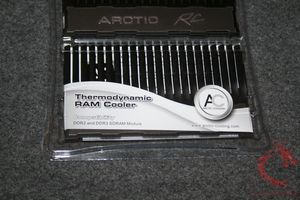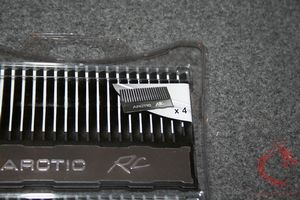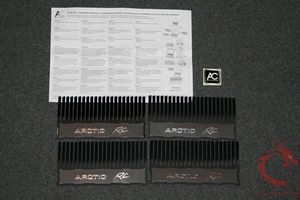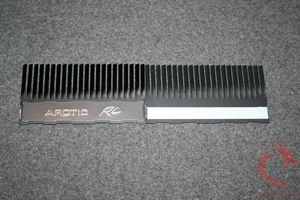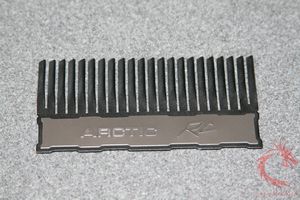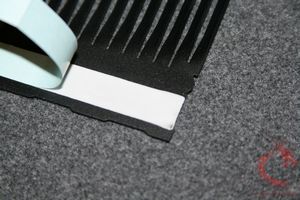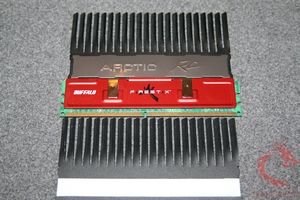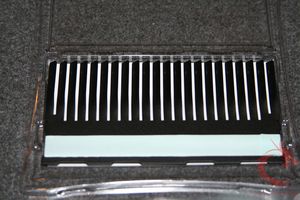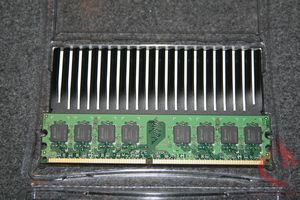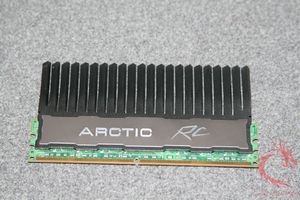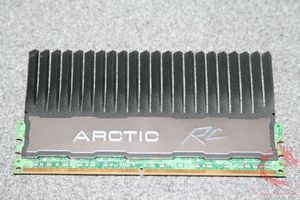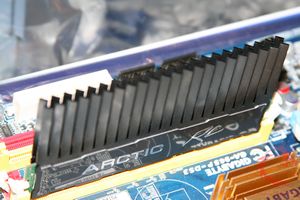Unboxing
Arctic Cooling packages the Arctic RC on a clear plastic blister card with the two spreaders prominently displayed. The bottom of the package has the Arctic Cooling logo on the bottom right and “Thermodynamic RAM Cooler” on the left.
The back of the package has two panels. The top lists the main features of the Arctic RC and the bottom shows a temperature comparison of a 1GB DDR3-1600 Module.
Opening the package we find four halves that comprise the two Arctic RC heat sinks. In addition there are instructions and an Arctic Cooling PC case sticker. Please note it is important not to throw out the blister packaging as it is used align and affix the heat sinks to the memory.
Each of the Arctic RC heat sinks comes in two halves. Each half is composed of polished black aluminum and measures 12.6 cm x 6.5 cm x 0.4 cm and one set weighs 29 grams. There are two distinct segments on the Arctic RC, the flat portion which attaches to the memory and the upper segment where we find the fins that are angled at approximately a forty five degree angle. There are twenty two of these fins on each half of the heat sinks.
The inner portion of each heat sink has a pre-applied stripe of thermal tape covered by a protective film.
On the front of each of the heat sinks is an attached grey metal badge with an embossed Arctic RC logo. Don’t forget to remove the protective plastic before plugging them into your machine so they don’t melt onto your motherboard.
Each Arctic RC is designed to cool either DDR2 or DDR3 memory modules and can fit two or four memory modules.
Installation, Testing and Comparison
Installation takes very little time. Just pick the memory you wish to use then place on of the heat sinks into the bottom of the blister pack. Next remove the protective film from the heat sink and carefully position the memory card onto the Arctic RC heat sink. Finally press down firmly to attach the memory to one side of the heat sink.
For a frame of reference here is the Arctic RC next to a Buffalo Firestix Memory Stick.
If you are planning on applying the heat sink to both sides, simply repeat the above process. Make sure that the two heat sink components are securely attached to the memory. Finally insert the Arctic RC cover heat sinks into your PC.
The Arctic RC increases the height of the memory with its fins but is no wider than standard heat sinks found on commercial covered memory. If your CPU heat sink is wide or over hangs the memory slots of your motherboard then please keep this in mind before applying the Arctic RC memory cooler.
Once again the installed Arctic RC compared to the Buffalo Firestix. Same width but much different heights.
For testing I used some Corsair Value Select 2 (2 x 1) GB DDR2 PC2-5300 memory running on
Gigabyte GA-965P-DS3 Rev 3.3
Intel Core 2 Duo E6600
OCZ Powerstream 520 Watt SLI
For testing I ran the memory at idle full load using Prime95 during the Blend Test which maximally stresses the memory and builds heat. Temperatures were measured using the JetArt Thermo Eye with the probe attached to the memory stick.
Running the memory at load without the heat sink I was able to get the temperature up to 48 degrees Celsius, while with the Arctic RC applied the memory ran at 39 degrees Celsius. Not the 34 degree drop that was advertised, still a decent 19% drop in temperature.


